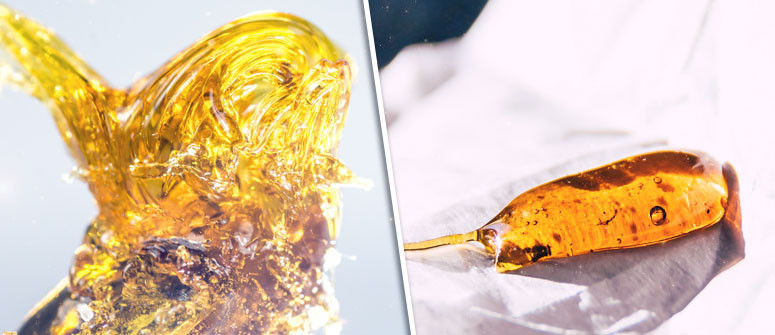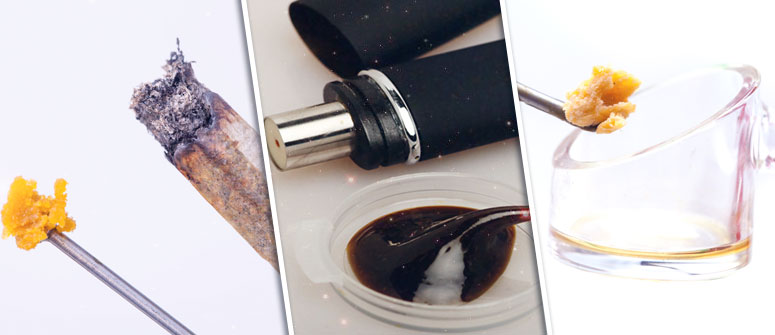What is marijuana wax, how is it made, and is it safe?

Confused about cannabis waxes, crumbles, honeycombs, and butters? Let's have an in-depth look at mariuana waxes, what they are, how they're made, and more.
We decided to clear up some confusion by taking an in-depth look at cannabis wax, a popular type of BHO sold under a variety of names including crumble, sugar, honeycomb, and budder. Extracts are leading the cannabis industry, and BHO’s (Butane Hash Oils) are fast becoming the biggest players in the concentrate scene.
Big dabbing instruments and vaporizers became hip and trendy, but back in the days I made sure i wouldn't leave the house without some weed and some rolling paper. Maybe I would remember to also pack a lighter, but that was about it.
Nowadays you see people who walk around with whole backpacks filled with smoking gear. A vaporizer used to be a thing you have at home on your desk, hidden from your mom.
SO WHAT IS CANNABIS WAX?
Cannabis wax is a type of BHO (Butane Hash Oil). It is made by using butane (a liquified gas) as a solvent to extract the main cannabinoids and terpenes from cannabis buds and trimmings.
The resulting mixture is then processed to produce a concentrate that looks a bit like beeswax. The process for making cannabis waxes varies to produce a variety of different products with unique textures and colours.
Similar to shatter, cannabis wax can boast cannabinoid concentrations of up to 80%. Unlike shatter, waxes aren’t translucent. This is mainly because they have been prepared in a way that agitates the molecules in the extract and produces cloudy, creamy and waxy final product.
Cannabis waxes are being sold under a variety of different names, such as honeycomb, crumble, and budder. The name depends on the consistency and texture of the specific wax.
Waxes with sticky, brittle textures are usually sold as honeycomb or crumble. Moist waxes with slightly creamier textures are usually sold as budder.
HOW IS CANNABIS WAX MADE?
The process for making cannabis wax is very similar to that of making shatter or other kinds of BHO.
Cannabis trimmings and buds are first blasted or soaked with liquified butane to separate the trichomes (white, resinous crystals with high concentrations of cannabinoids and terpenes) from the plant matter.
This creates a cannabinoid-rich mixture, which is heated in order to purge of as much butane as possible. Whereas cannabis shatter is simply heated and then left to rest, waxes are typically irritated during the purging phase, which is what gives them their unique texture.
Common ways to manipulate and agitate BHOs during the purging process include whipping, shaking, and stirring. The end result can be anything from a crumbly substance similar to solidified honey (often sold as sugar wax or sugar crumble) to a silky smooth concentrate, adequately sold as “budder.”
There is a common misconception that translucent concentrates are more pure than opaque extracts. But this is not true.
Whether a concentrate is translucent simply comes down to whether it was agitated (either on purpose or by mistake) during the purging process.
HOW TO USE CANNABIS WAX:

There are different ways to enjoy cannabis extracts like waxes. Remember that some particularly runny, sticky, or otherwise hard to handle waxes may not be suitable to mix in a joint or used in a vaporizer or hash pipe and may require the use of a dab or oil rig.
Mixing cannabis wax with flower:
Dry waxes, such as crumbles and sugars, can easily be sprinkled on top of a regular joint, blunt, or bong for an extra dose of cannabinoids. If you are a connoisseur, you should remember that the unique flavors of the concentrate will be hard to distinguish from the taste of the flower.
Hash pipes:
There are some newer hash pipes on the market that allow people to easily enjoy concentrates such as waxes. This way you don’t necessarily have to invest in a sophisticated (more expensive) vaporizer or rig. Just make sure the pipe you buy is specifically suitable for solvent-based extracts and not just kief or regular hash.
Vaporizers:
Vaporizers are best for any users wanting to avoid the health risks of smoking. While vaporizers traditionally could not be used for extracts, some newer models are making it possible.
However, most of these models are portable and some poorer quality portable vapes have been said to produce poor hits. This is usually because they are not able to reach high enough temperatures to properly vaporize the concentrate.
If you’re planning on vaporizing waxes and other types of solvent-based extracts, make sure you do your research to find a decent model.
Dabbing:
Extracts like waxes are often referred to as “dabs” because dabbings is the most common way to consume them. Dabbing involves the use of some specialized equipment. Namely a “nail”, a blowtorch, and a dab rig.
The nail is usually heated with a blowtorch (or electronically if you have an e-nail) and a small amount of concentrate is placed on top of it. The vapor produced from the heat is then inhaled through a specialized pipe, which often uses water as a filter.
WHAT ARE THE BENEFITS OF USING WAX?
As with all other types of BHO, cannabis waxes are great for users looking to get a powerful and immediate effect from cannabis.
Due to their high cannabinoid content, BHO concentrates allow recreational users to feel much more powerful effects than they would by smoking or vaping flower.
As it does taste a lot different than smoking and vaping cannabis many people like dabbing for the flavor as well.
Some users also treasure concentrates as the use of concentrates reaches the desired effects much faster.
IS MARIJUANA WAX SAFE?
BHO concentrates are criticised for a number of reasons.
Some stories of home explosions caused by amateur chemists trying to make hash oil at home have not helped the fact that there are growing (and justified) concerns about BHO. These concerns are about the safety of both producing and consuming a product made with such a volatile and potentially dangerous substance.
As there is still little regulation in place to ensure waxes and shatters have been correctly purged to ensure a clean and reliable product, there are also health concerns about consuming BHO.
The fact that these extracts contain up to 5 times more THC than regular flower also raises concerns about dosing and potentially “overdosing”. Luckily most people still believe that it is impossible to fatally overdose from any cannabis-derived product
While these are all legitimate concerns, we believe they could easily be resolved by legalization, regulation and providing good information. This way both users and non-users can rest assured that the concentrates going around are safe and reliable, both in their production and consumption.
So if you are planning to try out concentrates, make sure to be well informed and be careful. It can be surprisingly strong.
But mostly, enjoy!
For more details about the different kinds of cannabis concentrates currently available, make sure to check out this post for all you need to know: How to use concentrates.
.jpg)
.jpg)

.jpg)
